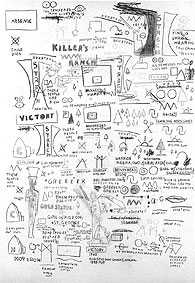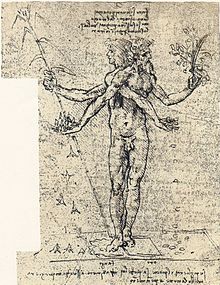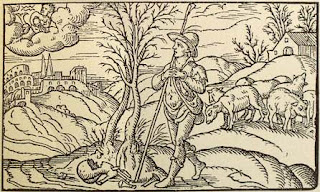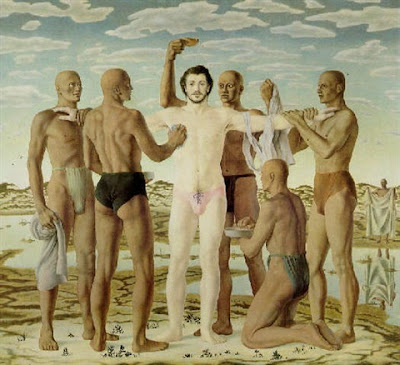Da Vinci's Hermetic Code of Humour.
How did people pass the time hundreds of years ago? Not with crosswords. Not with sudoku. But with elaborate jokes it seems: riddles for courtiers. An intriguing, though small, exhibition of Da Vinci’s work draws to the close in the UK. Its final stage—touching England, Scotland, Wales, will be Cardiff…in the next few weeks. The exhibition contains a double-sided set of drawings, from around 1490, when Da Vinci would have been at the mid-point of his life. The miniature drawings are accompanied by short texts in Italian…made even more mysterious by the fact that they are written in left-handed mirror writing.
The fascination of these drawings has to be the mind at play. The visual jokes work like this, a light-hearted Da Vinci code which puns on fragments of metaphysical mottoes.
One line of pictures shows a hill+a frying pan+a very modern looking man with a clock face, a cartoon from Disney almost. These spell col+padella+fortuna/time’s fate which conceals colpa della fortuna: a stroke of fate.
Another line shows a pear tree/pare=pero+horse saddle/sella+a sailing woman/fortune’s wind+two notes of music/mi, fa+a gentle fern/felce +tal+a face/vise+a black yarnwinder/aspo nero. The riddle reads Pero se (l)la fortuna mi fa fel(i)ce tal vise asponero: But if Heaven makes me happy I will show such a look.
Crammed onto a tiny piece of material based paper, the hieroglyphs bring another modern artist to mind: Basquiat. It wasn’t just Da Vinci’s anatomical drawings that informed his own traumatised obsession with bones, death and the body of work…from the dead bodies that Renaissance artists cut up to the dying corpus of black African male identity. The packing-in of visual puns is also used in his painted texts:

The fascination of these drawings has to be the mind at play. The visual jokes work like this, a light-hearted Da Vinci code which puns on fragments of metaphysical mottoes.
One line of pictures shows a hill+a frying pan+a very modern looking man with a clock face, a cartoon from Disney almost. These spell col+padella+fortuna/time’s fate which conceals colpa della fortuna: a stroke of fate.
Another line shows a pear tree/pare=pero+horse saddle/sella+a sailing woman/fortune’s wind+two notes of music/mi, fa+a gentle fern/felce +tal+a face/vise+a black yarnwinder/aspo nero. The riddle reads Pero se (l)la fortuna mi fa fel(i)ce tal vise asponero: But if Heaven makes me happy I will show such a look.
Crammed onto a tiny piece of material based paper, the hieroglyphs bring another modern artist to mind: Basquiat. It wasn’t just Da Vinci’s anatomical drawings that informed his own traumatised obsession with bones, death and the body of work…from the dead bodies that Renaissance artists cut up to the dying corpus of black African male identity. The packing-in of visual puns is also used in his painted texts:

Only one thing caused irritation in the whole of the exhibition—a piece of unBasquiat graffiti. The bottom right corner of the images are stamped with a royal ER+Crown. Not a clever visual pun, but a remainder of the imperial power that has come to own the artistic imagination of Da Vinci.





Comments